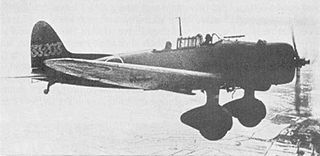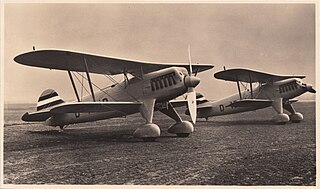Related Research Articles

The Aichi D3A Type 99 Carrier Bomber is a World War II carrier-borne dive bomber. It was the primary dive bomber of the Imperial Japanese Navy (IJN) and was involved in almost all IJN actions, including the attack on Pearl Harbor.

The Heinkel He 70 Blitz ("lightning") was a German mail plane and fast passenger monoplane aircraft of the 1930s designed by Heinkel Flugzeugwerke, which was later used as a bomber and for aerial reconnaissance. It had a brief commercial career before it was replaced by larger types. The He 70 had set eight world speed records by the beginning of 1933.

The Heinkel He 51 was a German single-seat biplane which was produced in a number of different versions. It was initially developed as a fighter; a seaplane variant and a ground-attack version were also developed. It was a development of the earlier He 49.

The Aichi B7A Ryusei was a large and powerful carrier-borne torpedo-dive bomber produced by Aichi Kokuki for the Imperial Japanese Navy Air Service during the Second World War. Built in only small numbers and deprived of the aircraft carriers it was intended to operate from, the type had little chance to distinguish itself in combat before the war ended in August 1945.

The Daimler-Benz DB 601 was a German aircraft engine built during World War II. It was a liquid-cooled inverted V12, and powered the Messerschmitt Bf 109, Messerschmitt Bf 110, and many others. Approximately 19,000 601's were produced before it was replaced by the improved Daimler-Benz DB 605 in 1942.

The Aichi D1A or Navy Type 94/96 Carrier Bomber was a Japanese carrier-based dive bomber of the 1930s. A single-engine, two-seat biplane based on the Heinkel He 50, the D1A was produced by Aichi for the Imperial Japanese Navy, remaining in service as a trainer at the time of the attack on Pearl Harbor. The D1A was produced in two variants, the D1A1, and the D1A2.

The Nakajima A1N, or Navy Type 3 Carrier Fighter, was a Japanese carrier-based fighter of the late-1920s and early-1930s. It was a licensed copy of the British Gloster Gambet fighter, built by the Nakajima Aircraft Company for the Imperial Japanese Navy. Approximately 150 were built in two versions, the A1N1 and A1N2.

The Douglas BTD Destroyer is an American dive/torpedo bomber developed for the United States Navy during World War II. A small number had been delivered before the end of the war, but none saw combat.

The Heinkel HD 28 was a reconnaissance seaplane developed in Germany in the 1920s for export to Japan. It was a conventional single-bay biplane with equal-span, unstaggered wings and three cockpits in tandem. The fuselage was braced to both the upper and lower wings with a number of struts on its sides, in addition to the normal cabane struts. The rudder extended below the line of the lower fuselage, and there was a large ventral fin fitted. The rearmost cockpit incorporated a ring mount for a gunner.

The Heinkel HD 25 was a two-seat shipboard biplane reconnaissance floatplane developed in Germany during the 1920s for production in Japan.
The Heinkel HD 26 was a reconnaissance seaplane developed in Germany during the 1920s for production in Japan. It was intended as a smaller, single-seat counterpart to the HD 25, to provide a spotter aircraft for warships, to take off from a short ramp. The HD 26 was a conventional biplane with staggered wings, twin float undercarriage, and an open cockpit.

The Heinkel HD 37 was a fighter aircraft, designed in Germany in the late 1920s, but produced in the USSR for Soviet Air Force service. It was a compact, single-bay biplane with staggered wings of unequal span, braced by N-type interplane struts. The pilot sat in an open cockpit, and the main units of the tailskid undercarriage were linked by a cross-axle.

The Aichi E3A was a reconnaissance seaplane developed in Germany as the Heinkel HD 56 to operate from warships of the Imperial Japanese Navy, which designated it the Type 90-1 Reconnaissance Seaplane. It was a conventional single-bay biplane with staggered wings braced by N-type interplane struts. The pilot and gunner sat in tandem, open cockpits.
The Heinkel He 62 was a reconnaissance seaplane designed in Germany in the early 1930s. It was a conventional, single-bay biplane with unstaggered wings of equal span. The pilot and gunner sat in tandem, open cockpits. A few aircraft were supplied to Japan, where Aichi built a version as the AB-5, and used it as the basis for the AB-6, but no series production took place. The AB-5 used a locally produced Nakajima Kotobuki in place of the Siemens engine fitted to the German-built aircraft.

The Aichi S1A 電光/Denko was a Japanese night fighter, intended to replace the Nakajima J1N1-S Gekkou. Like the Gekkou, it was to be equipped with radar to counter the B-29 air raids over Japan. Development time for the S1A increased while trying to overcome design shortcomings, such as the insufficient power of the Navy's requested Nakajima Homare engines, resulting in no aircraft being completed before the war ended.
The Aichi AB-6, or Aichi Experimental 7-Shi Reconnaissance Seaplane, was a prototype Japanese reconnaissance floatplane. It was a single-engined, three-seat biplane intended for the Imperial Japanese Navy, but only one was built, the rival aircraft from Kawanishi, the E7K being preferred.
The Kawanishi K-11 was a 1920s Japanese single-seat carrier fighter designed and built by the Kawanishi Aircraft Company to meet an Imperial Japanese Navy requirement. The type did not enter service and only two prototypes were built.

The Mitsubishi 1MF9 or Mitsubishi Experimental Taka-type Carrier Fighter was a prototype Japanese fighter aircraft of the 1920s. It was a single-engined, single-seat biplane intended to operate from the Imperial Japanese Navy's aircraft carriers, but only two were built, with the type being rejected by the Navy.

The Mitsubishi 1MF10 or Mitsubishi Experimental 7-Shi Carrier Fighter (七試艦上戦闘機) was a prototype Japanese monoplane single-seat carrier-based fighter aircraft of the 1930s. Two were built for the Imperial Japanese Navy, but both were lost in crashes, with no production following.
The Nakajima D3N was a Japanese carrier-based dive bomber of the 1930s. Three prototypes were built for the Imperial Japanese Navy, but no production followed, with the Aichi D3A being selected instead.
References
- Green, W. & Swanborough, G. (1994). The Complete Book of Fighters. London: Salamander Books. ISBN 1-85833-777-1
- Taylor, Michael J. H. (1989). Jane's Encyclopedia of Aviation. London: Studio Editions.